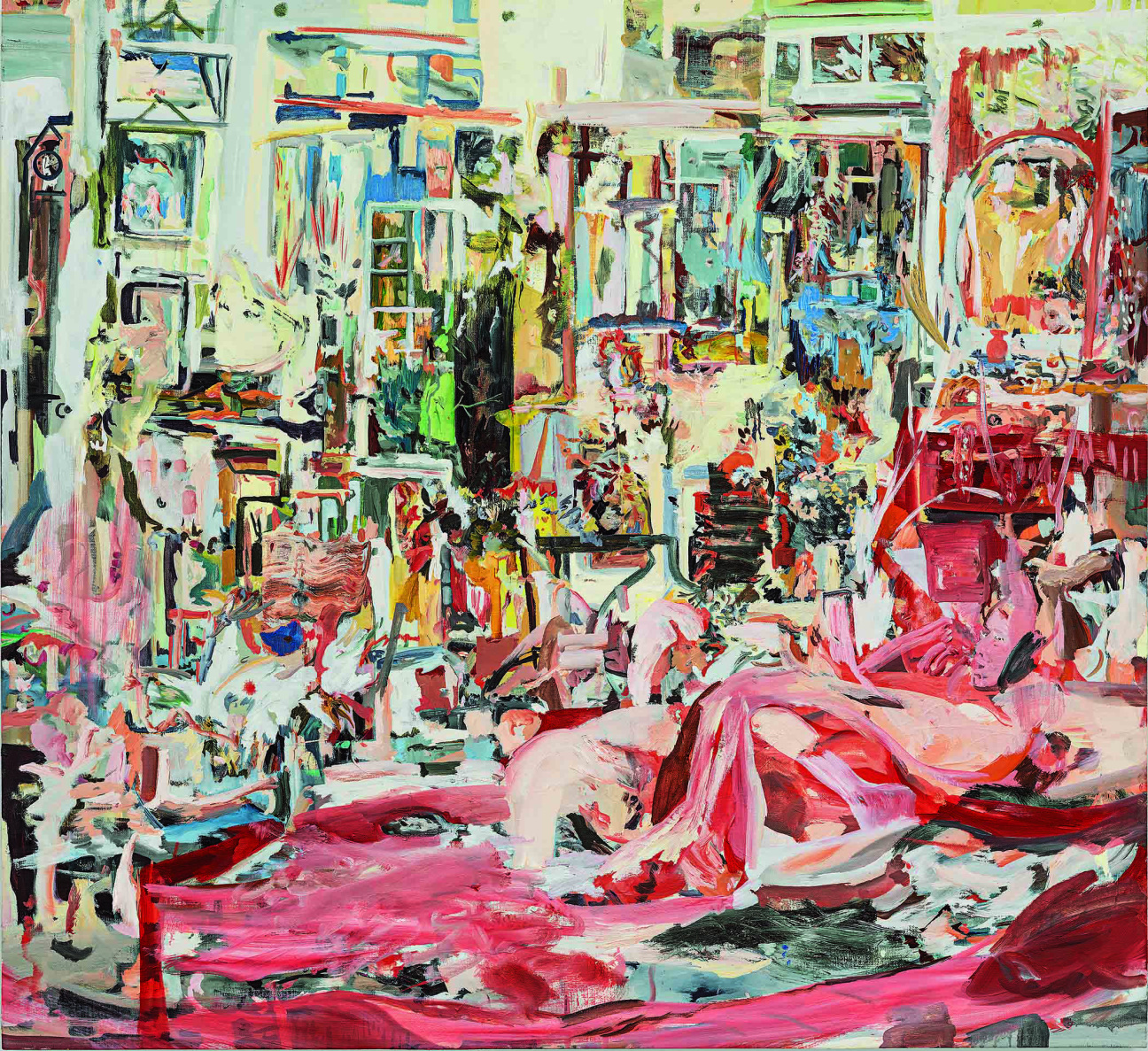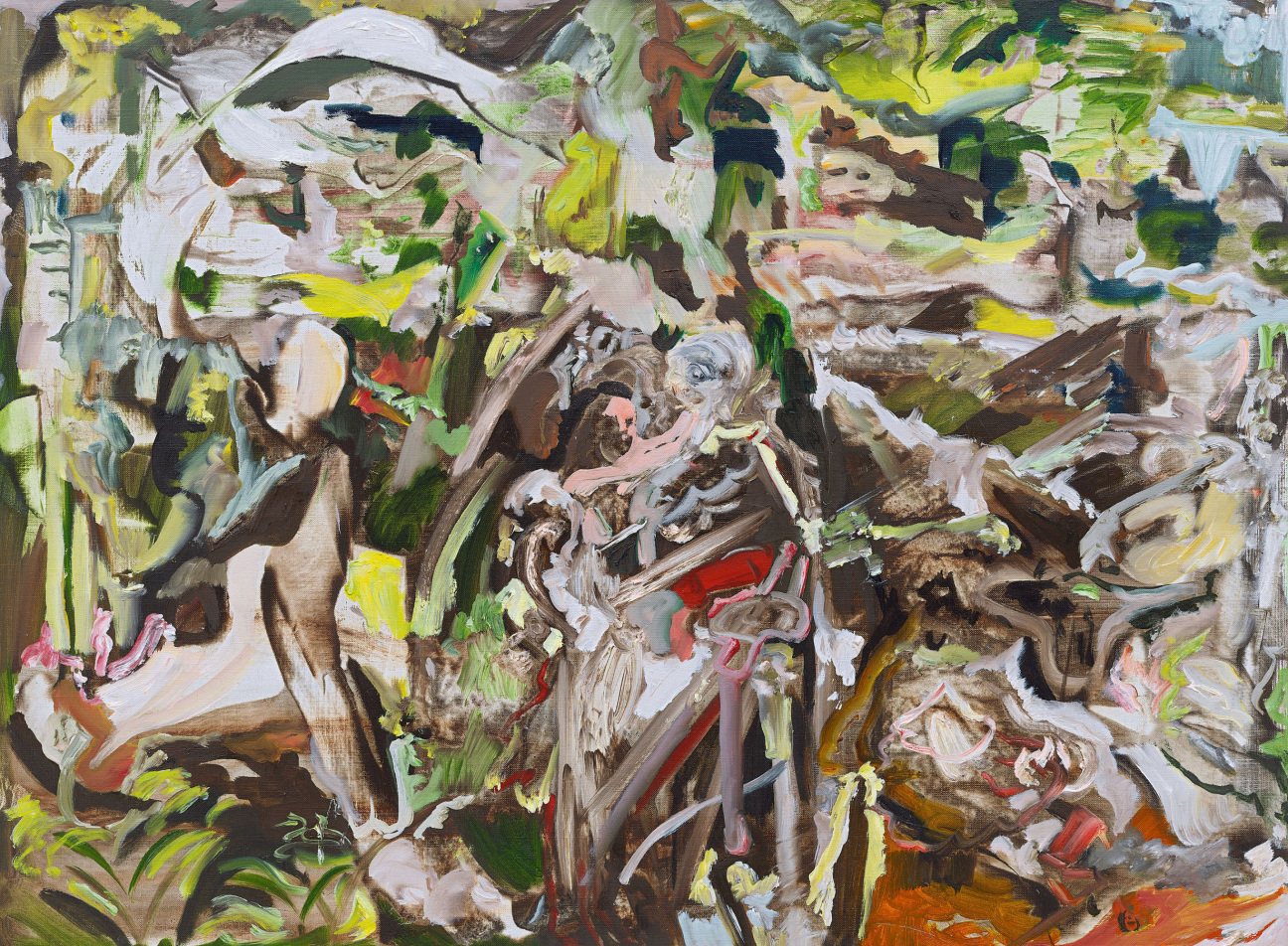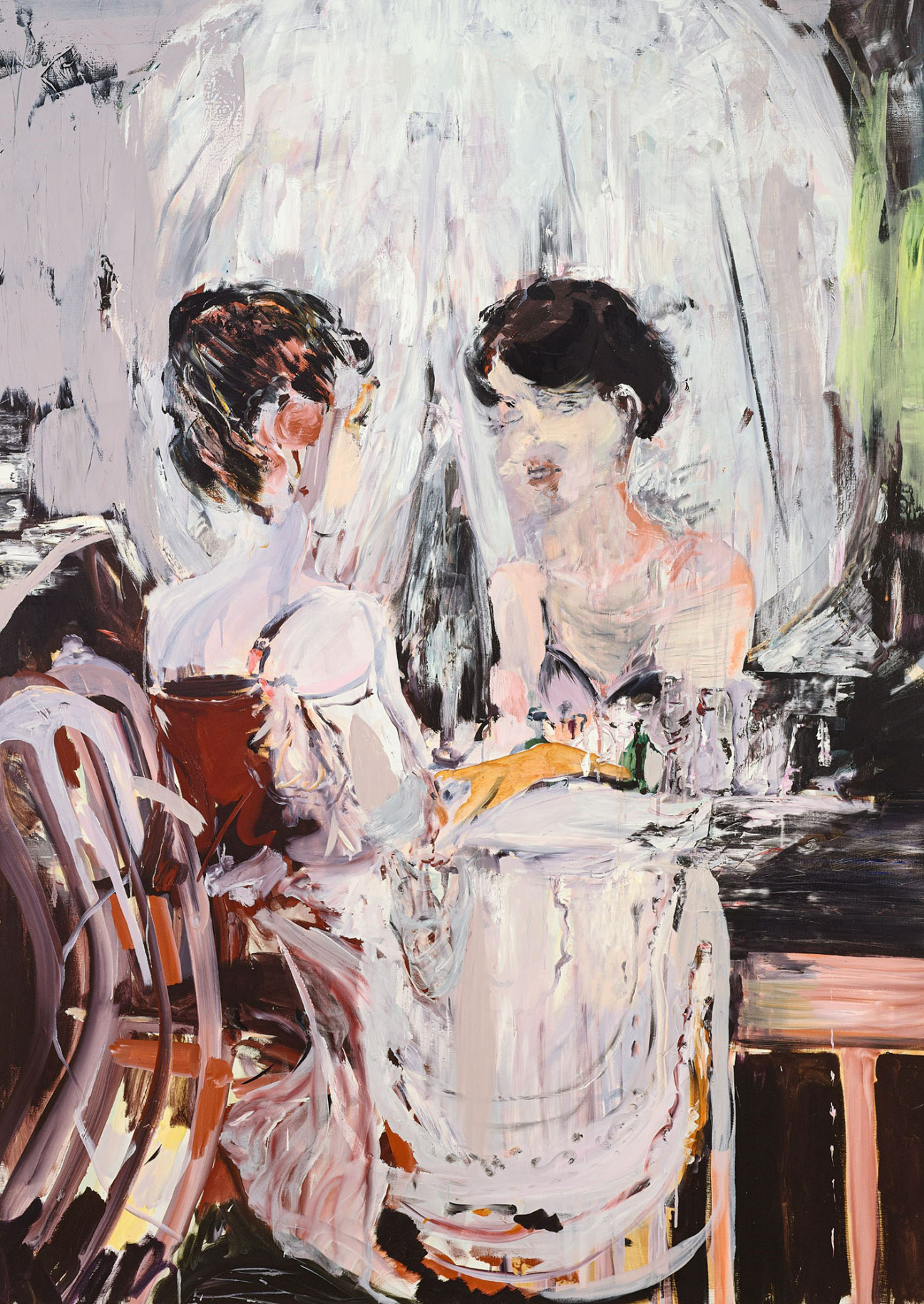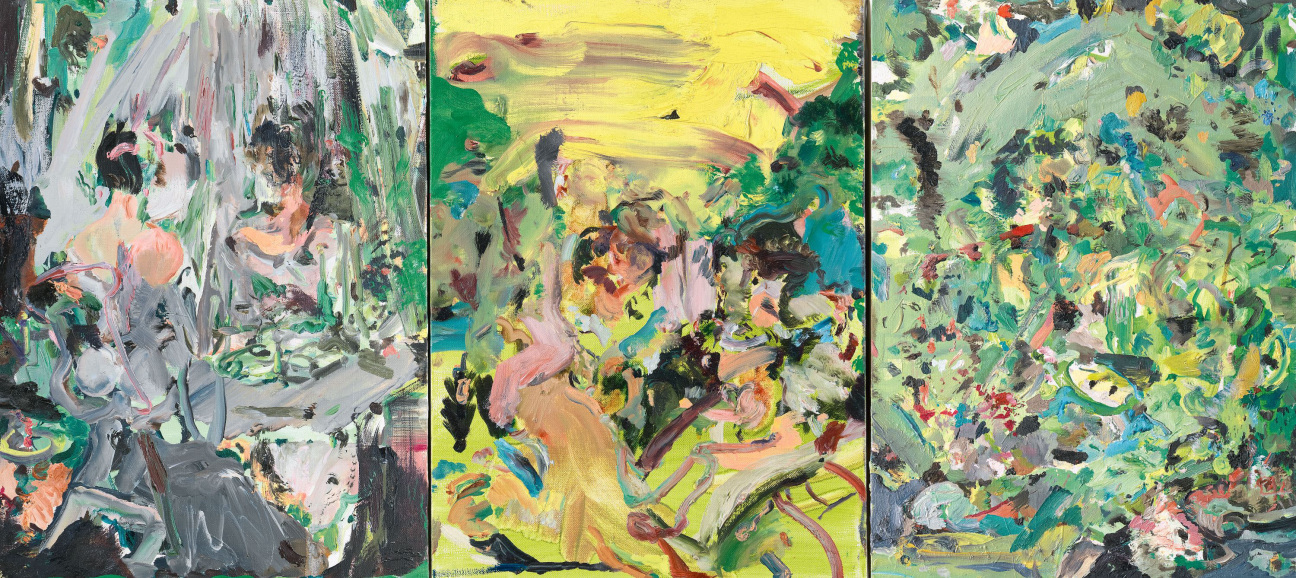
The cafe of the Metropolitan Museum of Art is quiet. The museum is closed. Without the bodies to absorb it, a voice can fly uninterrupted across centuries, vibrating off marble statues, polished armor, stretched canvas, wood carvings, and glass vases. We are alone with an encyclopedia of human history—a long winding version of us told through images and objects. Cecily Brown and curator Ian Alteveer have just put the final touches on the New York-based painter’s retrospective, “Death and the Maid,” which opens this week.
It is Brown’s first, and hotly anticipated, mid-career survey. The landmark exhibition comprises 47 works, including new and unseen pieces, all held between the bookends of Joan Miró’s amoeba-like abstractions and Florine Stettheimer’s candy-colored social commentary. The former’s influence on Brown’s painting is immediate, the latter’s following soon behind it. But arguably there is no place in this cavernous institution where her paintings would read as total non sequitur. The British artist is an aesthetic omnivore. “The Met is an ideal situation because my work does draw from everything but so much from other paintings,” she says. “I keep thinking how the echo of everything visitors have looked at will resonate while looking at [my show]. Say you were looking at Dutch still lifes and you've just seen a lemon on a table from the 17th century. Then you'll see a lemon in mine. It'll make you leap the centuries.” In this way, Brown is not so much a traveler as she is a time destroyer. She is someone for whom the past is constantly with us in a kaleidoscopic present. In fact, the only narrative the artist keeps out of her work is her own. Everyone else has been keen to tell it for her anyway.

“While we were installing,” Brown muses, “we were joking that wouldn't it be a fun project to install the worst version of someone's work? You could really tell a different story.” The Met certainly has its own version of history to tell, but so does its show on Brown. “Death and the Maid” lays out an account of her work no one has yet. It is one that doesn’t get lost in Brown’s proximity to men: It doesn’t dwell on the accolades of her father, the art historian David Sylvester, or on Sylvester’s relationship to Francis Bacon. Nor does it dally on the headlines of Brown’s meteoric rise early in her career, when the New York art world in its piggish desire for talent couldn't distinguish its lust for the work from the newly arrived author. (“Cecily On Top” and “She Can’t Be Bought” gives a gist of the situation.) “Death and the Maid” doesn’t even try to insinuate motherhood was the reason Brown became more abstract in her 40s. “Sexy” appears nowhere in the exhibition text. The word “erotic “is missing too, despite its repetition in almost every other piece of writing on Brown that proceeds it. Viewers familiar with the artist’s orgiastic images of smudgy rabbits and smeary couples intertwined in sex, or those used to looking for their signatures even in her more illegible work, will find themselves up the snatch of something much more intimate than legible genitalia or copulating beasts. Appearing out of the fog of juicy and furious space, they’ll discover death and its fingerprints lingering all throughout Brown’s work. It’s a body that's been there all along in the sheets of art history and sex, between the layers of oil and pigment. And in “Death and the Maid” it awakens, forever altering every reading of the work that came before it.

“I really liked Ian’s selection [of my work] because it’s not just: Started off sexy, went abstract, bit of landscape, had a baby, abstract again,” Brown says, flipping to her title painting in the exhibition catalog, one of two new works made for the show. “It traces something true back to the very beginning.” The curator describes it in his introductory essay as a “spectral embrace in a fantastic palette of dark green, gray, salmon pink, and dark yellow in which, after some inspection, one might make out the fatefully amorous couple in the center of the canvas–the long diagonal of Death’s leg stretching from center down to the left and intertwining with that of the maiden. Some questions, by now familiar, raced through my mind: Is this a nightmare or a dream? Is it heaven or is it hell?"
The title “Death and the Maiden” was born as a famous Franz Schubert lied, but has gone on to live a rich full life as an OK painting by Edvard Munch, a successful play by Ariel Dorfman, a movie by Roman Polanski starring Sigourney Weaver, and no doubt countless copies and homages. It is a riff on a reference to a reference to a reference and an idea raised by Alteveer who knows that Brown is a pillager of titles, especially from Hollywood. This one they plundered together, only Brown charmingly edited “maiden” to “maid.” And indeed, the concept of the maiden is cut and reoriented throughout the exhibition, turning the attention away from Brown’s private life towards something more alive in and essential to the work: its obsession with death and the way it dissolves so sweetly into the concerns of painting. Flipping through the catalog of “Death and the Maid,” the evidence is undeniable. Even in her earliest works, Brown has referenced mortality-facing tropes: memento mori, petite mort, danse macabre, and vanitas all appear. Almost every five years, she paints a skull, and in between loaded symbols filter in and out: ladders, mirrors, books, corsets, and high heels. Death, like any other stroke, can either tread on the surface of Brown’s painting or sink deep into the calamitous sea of the background. And what her new show inspires is not a hunt to snipe death’s individual cameos in the works, but its omnipresence across them: morbid, insatiable curiosity materialized as a type of time-obliterating brushwork forever fighting the physical reality of its two-dimensional nature.

Constant motion is endemic to Brown’s practice. The artist always has multiple pieces going at once, returning again and again to the same stretcher until it is complete. She fills sketchbooks with her own creations and draws in the margins of pre-existing books. Both those compositions and her paintings, in their wildness and ambition, betray a certain level of agility and athleticism in the studio that should've earned Brown more connections to action painters like Helen Frankenthaler and Joan Mitchell back when she first arrived on the scene as a wunderkind on Larry Gagosian’s roster. It is truly only now, with this exhibition, that it feels like the art world is catching up to not only how grand Brown’s contributions have been, but to their complexity and diversity, too.
Setting auction records is one thing, proving mastery over one’s craft is another. Over the past almost three decades, Brown has demonstrated her fluency in paint no matter the scale, flowing freely between figuration and gesture, landscape and portrait, a native of every genre. She has forged an idiosyncratic hand that is recognized and prized, not for its rigid sameness, but for its ability to make any subject its own. It is harder than it looks. “I'm trying to be more figurative at the moment, and it is really hard for me to just sign off and say, ‘It is a shoe,'" she explains. “It seems more real to me when it's not trying to state a fact, but saying everything is mutable and is not what you think. When it gets more figurative, it's partly a technical thing that if I'm going to paint a side of ham, is it going to be like [Jean Siméon] Chardin's ham or [Chaïm] Soutine's? Who's to say? It is self-deprecation to the point of annihilation because I'm like, My ham is going to be shitty if I really try to paint my best ham."

Ironically, Chardin, Soutine, Edgar Degas, Willem de Kooning, and Munch, all are artists whom Brown has taken from—some more directly than others. But Western canon isn’t the only reference swirling in the meaty pink and red register of Brown; Saturday morning cartoons, Ladybird Books, and shunga (Japanese erotica) are in there, too. The artist feels affinity for drawn narratives because of their economy and fundamental appreciation for the polysemous nature of a mark. “Go make a mark, any mark, and it nearly always suggests a figure. And more often than not, it suggests a female figure. Often I'm like, What happens if I try not to let the figure come? It's really hard for the figures not to constantly emerge,” Brown confesses. “What I like about when it's not so overt is that you can see it, but you don't have to see it. I’m trying to develop this language where a black slash can be an eye, a mouth, an ear, a vulva, or armpit. Using that repetition until it almost becomes irrelevant which one it is. I always want to reduce things. How little do you need to give for the human mind to fill it in and complete it?”
Having buried the bodies, “Death and the Maid” leaves ample room for the viewer’s uncertainty, but also for its maker’s.
“Death and the Maid” is on view through December 3, 2023 at the Metropolitan Museum of Art in New York.










 in your life?
in your life?

